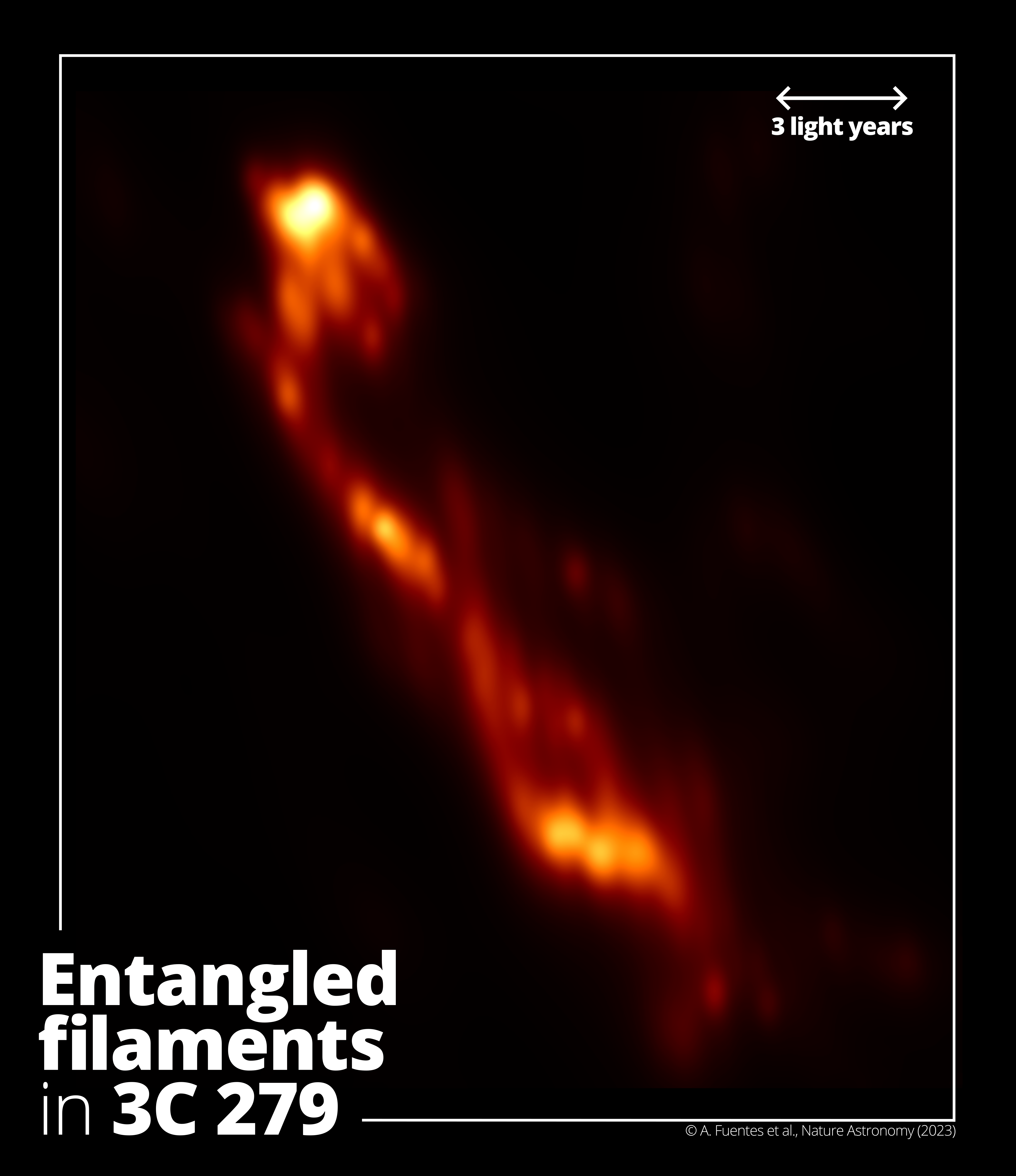
High-resolution image of the relativistic jet in the blazar 3C 279 obtained with RadioAstron. The image reveals a complex structure within the jet with several parsec-scale filaments forming a helix shape. Credit: RadioAstron/Fuentes et al.
Paper: "Filamentary structures as the origin of blazar jet radio variability" by Fuentes et al. In Nature Astronomy: , https://doi.org/10.1038/s41550-023-02105-7
The Institute of Astrophysics of Andalusia (IAA-CSIC) leads the observation at the highest angular resolution and sensitivity of the jet emerging from the core of the galaxy 3C 279 at nearly the speed of light.
The image obtained reveals large helical filaments close to the central engine, the existence of which requires an alternative model to the one employed for four decades to explain the variability of these jets.
Blazars are the most powerful continuous sources of radiation in the universe. Like other active galaxies, they exhibit a structure consisting of a central supermassive black hole surrounded by a feeding material disk. However, they belong to the 10% of active galaxies that display high-speed plasma jets emerging from both poles, and an even smaller percentage of cases allows us to observe these jets almost head-on. Now, a group of researchers led by the Institute of Astrophysics of Andalusia (IAA-CSIC) has observed the jet of the galaxy 3C 279 with unprecedented resolution and has discovered large filaments with a double helix structure that requires an update to the theoretical models used until now.
"Thanks to RadioAstron, a space radio telescope capable of reaching distances close to the Moon, and a network of twenty-three radio telescopes distributed throughout the Earth, we have obtained the highest-resolution image of the interior of a blazar to date, allowing us to observe the internal structure of the jet for the first time", says Antonio Fuentes, a researcher at the Institute of Astrophysics of Andalusia (IAA-CSIC) leading the work.
The results, published in Nature Astronomy, reveal that the jet in 3C 279 displays a complex structure composed of at least two helical filaments extending from near the core to over 570 light-years away. This is an unprecedented structure and builds upon a previous result: in 2020, the Event Horizon Telescope (EHT), which captured the first image of a black hole in 2019, revealed unexpected structures in the core of 3C 279, but EHT's sensitivity was insufficient to observe the filaments.
"The properties of the helical filaments lead us to conclude that they are caused by instabilities in the plasma that makes up the jets. Taking all the elements into account, we discovered that the model used for four decades to explain the radio variability associated with the jets does not apply in this case. Therefore, we propose an alternative model that takes into account the newly observed structures", says Fuentes.
Furthermore, the study suggests the presence of a helical magnetic field that confines the jet. Therefore, it is the magnetic field, which in 3C 279 rotates clockwise around the jet, that channels the material traveling along it at a speed of 0.997 times the speed of light.
"This result, along with other recent findings, suggests that blazar jets have a complex and rich internal structure beyond the funnel-like morphologies observed in lower-resolution studies. Our results also open the door to the reinterpretation and reanalysis of many other sources of this kind, highlighting the importance of new global networks of radio telescopes with higher angular resolution and sensitivity, such as the Next Generation EHT in the next decade and, in the longer term, space missions operating at millimeter wavelengths", concludes José Luis Gómez, a researcher at IAA-CSIC and co-author of the study.
Leonid Gurvits, astrophysicist at JIVE and co-author of the paper, emphasises the significance of this research: "The result, presented in the paper by Fuentes et al., demonstrates the ability to study innermost areas of active galactic nuclei, the most powerful engines of the Universe, by a combination of a spaceborne radio telescope and a global Earth-based network of VLBI radio telescopes at its best. An important component of this global scientific instrument of the size larger than our planet is the European VLBI Network (EVN)”.
Additional information about JIVE
The Joint Institute for VLBI ERIC (JIVE) has as its primary mission to operate and develop the European VLBI Network data processor, a powerful supercomputer that combines the signals from radio telescopes located across the planet. Founded in 1993, JIVE is since 2015 a European Research Infrastructure Consortium (ERIC) with seven member countries: France, Italy, Latvia, the Netherlands, United Kingdom, Spain and Sweden; additional support is received from partner institutes in China, Germany and South Africa. JIVE is hosted at the offices of the Netherlands Institute for Radio Astronomy (ASTRON) in the Netherlands.
The European VLBI Network (EVN) is an interferometric array of radio telescopes spread throughout Europe, Asia, South Africa and the Americas that conducts unique, high-resolution, radio astronomical observations of cosmic radio sources. Established in 1980, the EVN has grown into the most sensitive VLBI array in the world, including over 20 individual telescopes, among them some of the world's largest and most sensitive radio telescopes. The EVN is composed of 13 Full Member Institutes and 5 Associated Member Institutes.
References
A. Fuentes, J. L. Gómez et al. "Filamentary structures as the origin of blazar jet radio variability". Nature Astronomy, 7, https://doi.org/10.1038/s41550-023-02105-7
More information
Antonio Fuentes, afuentes@iaa.es
José Luis Gómez, jlgomez@iaa.es
Contact at the Instituto de Astrofísica de Andalucía:
Silbia López de Lacalle, sll@iaa.es 958230676
Manuel González García, manuelg@iaa.es 958230566
Contact at JIVE:
Leonid Gurvits, lgurvits@jive.eu
Ioanna Kazakou, kazakou@jive.eu
